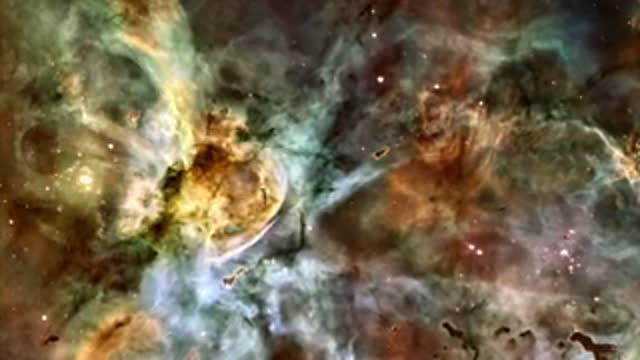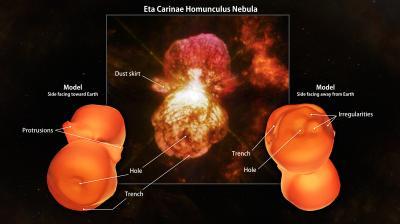The shape model, which is now published by the journal Monthly Notices of the Royal Astronomical Society, was developed using only a single emission line of near-infrared light emitted by molecular hydrogen gas. The characteristic 2.12-micron light shifts in wavelength slightly depending on the speed and direction of the expanding gas, allowing the team to probe even dust-obscured portions of the Homunculus that face away from Earth.
"Our next step was to process all of this using 3-D modeling software I developed in collaboration with Nico Koning from the University of Calgary in Canada. The program is simply called 'Shape,' and it analyzes and models the three-dimensional motions and structure of nebulae in a way that can be compared directly with observations," said lead researcher Wolfgang Steffen, an astrophysicist at the Ensenada campus of the National Autonomous University of Mexico.
The new shape model confirms several features identified by previous studies, including pronounced holes located at the ends of each lobe and the absence of any extended molecular hydrogen emission from a dust skirt apparent in visible light near the center of the nebula. New features include curious arm-like protrusions emanating from each lobe near the dust skirt; vast, deep trenches curving along each lobe; and irregular divots on the side facing away from Earth.
"One of the questions we set out to answer with this study is whether the Homunculus contains any imprint of the star's binary nature, since previous efforts to explain its shape have assumed that both lobes were more or less identical and symmetric around their long axis," explained team member Jose Groh, an astronomer at Geneva University in Switzerland. "The new features strongly suggest that interactions between Eta Carinae's stars helped mold the Homunculus."
Every 5.5 years, when their orbits carry them to their closest approach, called periastron, the immense and brilliant stars of Eta Carinae are only as far apart as the average distance between Mars and the sun. Both stars possess powerful gaseous outflows called stellar winds, which constantly interact but do so most dramatically during periastron, when the faster wind from the smaller star carves a tunnel through the denser wind of its companion. The opening angle of this cavity closely matches the length of the trenches (130 degrees) and the angle between the arm-like protrusions (110 degrees), indicating that the Homunculus likely continues to carry an impression from a periastron interaction around the time of the Great Eruption.
Once the researchers had developed their Homunculus model, they took things one step further. They converted it to a format that can be used by 3-D printers and made the file available along with the published paper.
"Now anyone with access to a 3-D printer can produce their own version of this incredible object," said Goddard astrophysicist Theodore Gull, who is also a co-author of the paper. "While 3-D-printed models will make a terrific visualization tool for anyone interested in astronomy, I see them as particularly valuable for the blind, who now will be able to compare embossed astronomical images with a scientifically accurate representation of the real thing."

NASA Goddard astrophysicists Ted Gull and Tom Madura discuss Eta Carinae and their new model of the Homunculus Nebula, a shell of gas and dust ejected during the star's mid-19th century eruption.
(Photo Credit: NASA's Goddard Space Flight Center)

A new shape model of the Homunculus Nebula reveals protrusions, trenches, holes and irregularities in its molecular hydrogen emission. The protrusions appear near a dust skirt seen at the nebula's center in visible light (inset) but not found in this study, so they constitute different structures.
(Photo Credit: NASA Goddard (inset: NASA, ESA, Hubble SM4 ERO Team))
Source: NASA/Goddard Space Flight Center